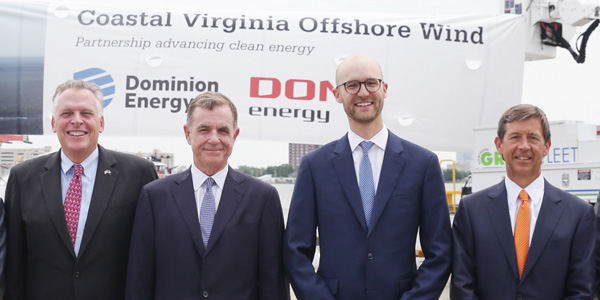By Rich Heidorn Jr.
Dominion Energy announced Monday it will build the second offshore wind project in the U.S.: two 6-MW turbines about 27 miles off the coast of Virginia Beach.
The Coastal Virginia Offshore Wind project, which would be the first offshore project connecting to PJM, follows the 30-MW, five-turbine Block Island Wind Farm off Rhode Island, which went into operation in December.
Dominion said DONG Energy of Denmark will begin engineering and development work immediately on the project. The turbines should be installed by the end of 2020, assuming no delays from weather or protected species migration.
The project will build on preparatory work performed under the Virginia Offshore Wind Technology Assessment Project and be located on a 2,135-acre site leased by the state Department of Mines, Minerals and Energy. Power will be delivered via a buried 34-kV distribution line to a connection point near the Virginia National Guard’s Camp Pendleton.
The state’s site is adjacent to the 112,800-acre site leased by Dominion from the U.S. Bureau of Ocean Energy Management (BOEM), an area with the capacity for 2,000 MW.
“Today marks the first step in what I expect to be the deployment of hundreds of wind turbines off Virginia’s coast that will further diversify our energy production portfolio, create thousands of jobs and reduce carbon emissions in the commonwealth,” said Gov. Terry McAuliffe, who attended the announcement at the Portsmouth Marine Terminal in the Hampton Roads area of Virginia. “Hampton Roads has the ideal port assets and talented workforce to attract and house the offshore wind business supply chain to support not only Virginia’s commercial wind area but also wind farms under development in Massachusetts, New York and Maryland.”
“While we have faced many technological challenges and even more doubters as we advanced this project, we have been steadfast in our commitment to our customers and the communities we serve,” Dominion CEO Thomas Farrell II said.
Dominion lost $40 million in federal grants for the project last year when the U.S. Department of Energy said it wasn’t moving fast enough. In addition, bids on construction came in at about $400 million, almost double Dominion’s $230 million projection. The project was revived after DONG agreed to build it under a fixed-price contract of about $300 million.
Farrell’s comment also seemed an apparent response to critics who had worried that the utility would not develop its wind energy area, which it won in a BOEM lease auction in September 2013. (See Will an Old Utility Learn New Tricks?)
The company’s 2017 integrated resource plan, filed May 1, estimates the cost of offshore wind at $339/MWh, more than triple that for onshore wind ($99/MWh) and almost five times the cost of a 3×1 combined cycle plant ($70/MWh).
The high cost of offshore wind is particularly challenging in Virginia: The state does not have a mandatory renewable portfolio standard nor retail choice, which could create a niche for a green alternative. Despite that, Dominion has set a voluntary goal to obtain 15% of its power from renewables by 2025.
Excluding pump storage (9%), renewables represent 3% of its current capacity.
“We welcome the news that Dominion is making steps to bring offshore wind to Virginia. But this should have happened years ago,” said Mike Tidwell, executive director of the Chesapeake Climate Action Network. “Dominion already lost a federal grant for $40 million for dragging its feet on the project. Will ratepayers have to foot that bill?
“Meanwhile, Dominion continues to push for dangerous climate-warming fossil fuel projects like the Atlantic Coast pipeline, along with the support of Gov. Terry McAuliffe,” he continued. “The offshore wind pilot project is nowhere near what’s needed to bring us to a clean energy economy. If McAuliffe and Dominion were truly serious about helping Virginia become a leader in clean energy, they would stop pushing for fracked-gas pipelines and start focusing on expanding clean energy.”
Eileen Levandoski, assistant director of the Sierra Club’s Virginia Chapter, also criticized the pace of Dominion’s progress. “While the commitment to 12 MW by 2020 is helpful, the crisis we face with climate change demands that Dominion also engage aggressively on the commercial lease area and immediately commit to 400 [MW] by 2022 and 2,000 by 2030,” she said.
Dominion officials say the initial project will test whether the turbines can withstand hurricanes, and that it will not interfere with marine life and whale migrations. If turbine prices continue to decline, a larger project will begin operating by the mid-2020s, they said.
[Editor’s Note: An earlier version of this article incorrectly stated that the Dominion’s offshore distribution line would connect with the utility’s grid near “Marine Corps Base Camp Pendleton,” which is in California.]





